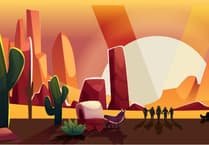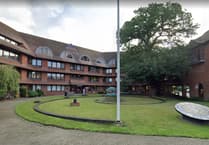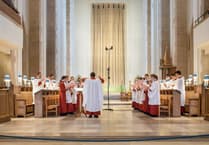Spring has been glorious this year, with welcome warmth, uplifting birdsong and bright colours: blue skies, vibrant green leaves and blooms in a multiplicity of hues.
By now, birds are raising their broods in hedgerows and heather, trees and nest boxes. Atop Export House in Woking town centre, a pair of peregrine falcons are busy feeding their chicks. We can watch them, thanks to a live nest webcam on the Woking Peregrine Project website (www.wokingperegrines.com), now in its tenth year.
As I write, the young falcons are being fed a blue tit. Unfortunately, this small bird is unlikely to satisfy them for long; the “kill” on most occasions (at least, when I’ve witnessed feeding in progress) has been a pigeon, which carries much more meat to sate their appetites.
Surrey Bird Club (which is funding the live-stream) will set up telescopes for the public in Jubilee Square, Woking town centre, on Saturday, June 7, and again on Saturday, June 21, when it’s expected we’ll see the youngsters venturing onto the ledges. The club says that if you visit on the second date, you should be able to see them taking to the skies!
For nature news from elsewhere in our area, I often look at the Natural Goldsworth Park group on Facebook, where enthusiastic nature-lovers post reports and photos. As group members attest, a vast variety of wild plants, creatures and fascinating fungi have made Goldsworth Park their home.
Unlike most local community groups on Facebook – where it can be difficult to find “real” news nowadays due to being swamped with business posts – the Natural Goldsworth Park group avoids marketing clutter. It’s just fascinating nature news and fabulous photos.
Among many posts by regular contributor Liz Wilkinson, with her photos of the wild plants and fungi she has spotted in Goldsworth Park, are her reports on patches of yellow rattle coming into flower across the meadow to the north of Goldsworth Park Lake.
Seeding of yellow rattle took place in more than a hundred places on the meadow last year – led by Tina Hartley, Treasurer of the Goldsworth Park Community Association – as part of efforts to transform the grassland into a species-rich wildflower meadow. The hope is that the yellow rattle will thrive and then self-seed and spread naturally across the area.
Yellow rattle, which has yellow, tube-like flowers, is commonly introduced to encourage the conversion of grassland into wildflower meadow. It is semi-parasitic: it leeches nutrients from the root systems of grasses, making them weaker. This allows less robust wildflowers an opportunity to thrive.
Meanwhile, a pair of swans on Goldsworth Park Lake have hatched six cygnets – although, as I write, one cygnet is reported missing and presumed dead. I must encourage you to look at the numerous superb photos of the family taken by Gary Medhurst and posted on the Goldsworth Park Residents’ Forum group on Facebook. Gary has kindly given permission for one of them to be published here.
If you love nature, the Wildlife Trusts – including Surrey Wildlife Trust – are once again running the month-long nature challenge 30 Days Wild during June. With special free packs full of inspiration, with activity ideas designed to help everyone get closer to nature, including a special kids’ pack. Sign up now at wildlifetrusts.org/30dayswild to receive your free goodies in the post.





Comments
This article has no comments yet. Be the first to leave a comment.